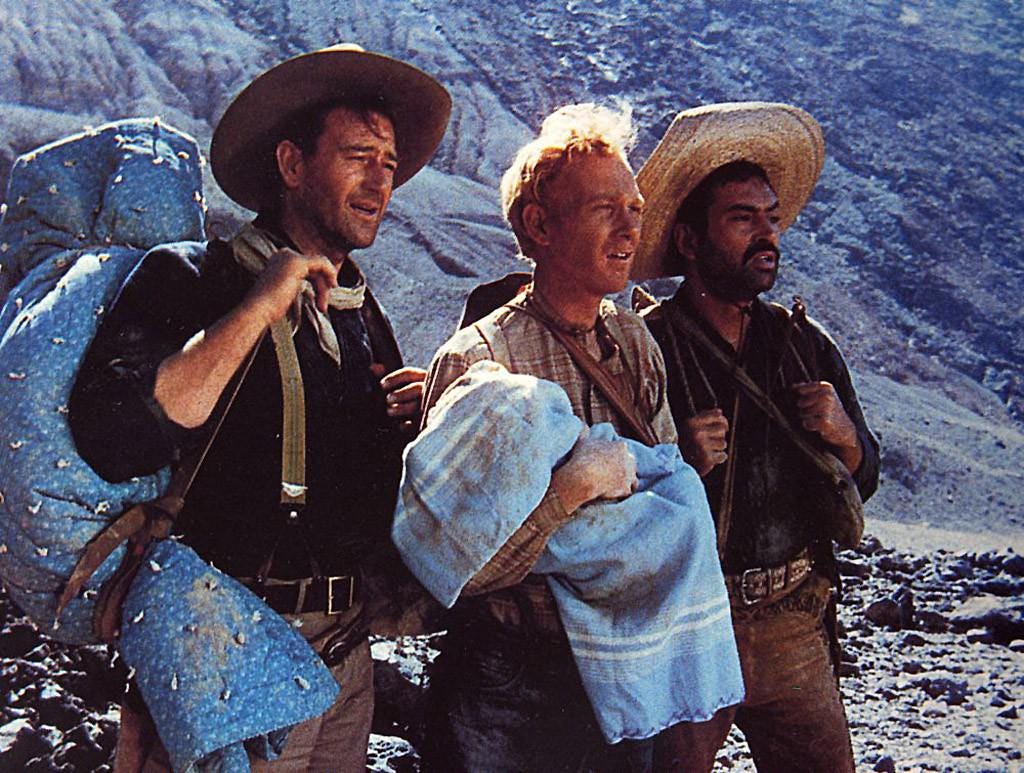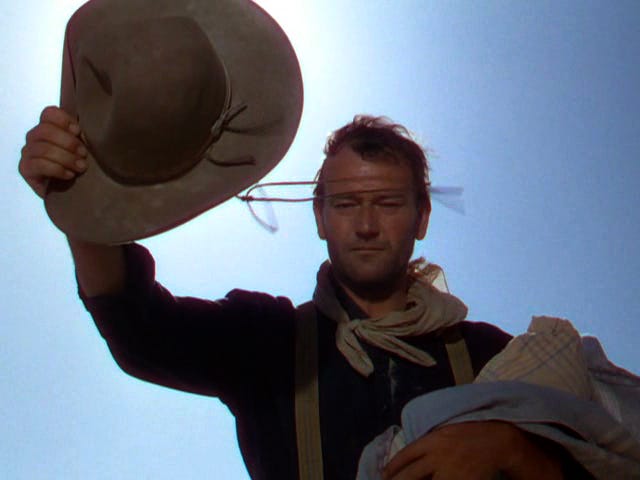Reeling Backward: 3 Godfathers (1948)
A lesser partnership between the Johns -- Ford and Wayne -- this sentimental Western about three outlaws and a baby stresses the theme of civilization vs. chaos, faith/order vs. the law of the gun.
You’d never guess it from its first half, but “3 Godfathers” is a Christian parable about the three wise men who travel across the desert to bring gifts to the baby Jesus. It starts out as a typical John Ford Western, lean and gruff, and the second half dives head-first into sentimentality, bordering on mushiness.
It’s a lesser work in the long pairing of Ford with the other iconic John, Wayne — 14 pictures altogether. But it’s an still interesting flick, exploring Ford’s favorite theme: the ongoing struggle between civilization vs. chaos, faith/order vs. the law of the gun.
“Godfathers” also features plenty of Ford’s regular cast of stock actors — Ward Bond, Jane Darwell, Ben Johnson, Hank Worden among them — and his favorite songs for Westerns, including “Bringing In the Sheaves,” “Streets of Laredo” and, of course, “Shall We Gather at the River,” which I swear must appear in at least 50 percent of Ford movies. It was shot in his preferred backdrop of Death Valley.
The film has an interesting progeny. Based on a novelette by Peter B. Kyne that was originally published in the Saturday Evening Post, it had already been translated into film seven times before — including once by Ford himself, in 1919’s silent “Marked Men” featuring Harry Carey. Believe it or not, Carey had also starred in another adaptation three years earlier.
A couple of other legendary directors, D.W. Griffith and William Wyler, made their own stabs in 1913 and 1929, respectively — the latter, “Hell’s Heroes,” marking Wyler’s first sound picture. The 1948 version is actually considered a remake of Wyler’s film rather than Ford’s own. There was also a 1936 adaptation starring Chester Morris, a lost 1921 silent movie and an animated parody featuring Oswald the Lucky Rabbit.
Its legacy is less commented upon, but I think this theme of antiheroes hardened by violence who morph into protectors of children became a common one in the decades after, from “Shane” to “Gloria” to “La Femme Nikita.” The comedic aspect of men who prove inept around babies has carried on in “Three Men and a Baby” (and the French original), “Mr. Mom” and so forth.
The screenplay is credited to Ford mainstays Laurence Stallings (three scripts together, including “She Wore a Yellow Ribbon” the following year) and Frank S. Nugent (11 scripts, including “Yellow” and “The Searchers”). Ford was notoriously tough to work with, but people kept coming back for a reason.
It’s a straightforward story, mostly chase-chase.
Three outlaws ride into the town of Welcome, Ariz., with the intent of robbing the bank. They’ve mostly contented themselves with low-end, non-violent crimes, rustling cattle and such, and lead man Bob Hightower (Wayne) instructs his partners under no circumstances are they to shoot anyone. His sidekicks are Pedro Encarnación Arango y Roca Fuerte (Pedro Armendáriz), aka “Pete,” and William Kearney, better known as “The Abilene Kid.”
The Kid was played by Harry Carey Jr., in a clear homage to his pops, who died of cancer the year before. The opening of the film even includes a salute to Carey Sr. with stuntman Cliff Lyons portraying him in silhouette atop his favorite horse, Sonny, dubbing him an “Early Star of the western sky.”
Nonetheless, Ford still gave Kid Carey a helluva time on the shoot, abusing him so badly he planned to quit until Wayne talked him out of it.
Notably, Carey Jr. is given an “introducing” credit, which is curious as he’d already appeared in a number of pictures, including in a superior John Wayne Western, “Red River,” that came out a few months before this one.
If Bob, Pete and The Kid are trying to avoid attention before their robbery, they’re pretty terrible at it. They strike up a conversation with a seemingly docile fellow tending to his garden, amused by the name on the shingle outside his house, B. Sweet. That’s short for Buck, but titters turn to guffaws when his wife (Mae Marsh) reveals his nickname, Perley.
After sharing coffee and introductions — The Kid provides his real name and outlaw moniker — Perley pulls on his waistcoat to reveal the tin star marking him as the marshal. Their antagonism is thus launched, and Perley nearly foils the robbery, shooting The Kid in the shoulder, and giving chase.
Perley refuses to shoot the fleeing desperadoes — “They don’t pay me to kill people” — even though he has skill enough with the rifle to plug a hole in their big water bag, knowing this will limit their movement in the stark Arizona desert. Bob and the gang intend to make for the Mexican border 60 miles to the south. But they’re short one horse, and there’s few man-made water sources in the area.
Wily Perley hastily organizes a freshly-deputized posse, and uses the train to beat the robbers to the closest reservoir, Apache Wells. He leaves four men there with Winchesters, figuring Bob is too smart to try to ambush deputies with long guns using only six-shooters. He and the rest of the posse stake out the next closest, Mojave Tanks, around which a small depot has been built, run by old maid Miss Florie (Darwell). She’s all too happy to have some menfolk around, bragging that she’ll bag herself a husband before the bandits are caught.
Bob reckons to out-think Perley by double-backing to the Terrapin Tanks to the northeast, figuring they’ll then travel eastward to the town of New Jerusalem before making for the border. Perley eventually figures this out for himself and heads that way.
Trouble is, Terrapin Tanks has been dynamited by an idiot wagon-trainer making his way out west, thinking this would refill the reservoir rather than destroy it. He ran off somewhere and died, leaving his very pregnant wife on her own. Pete helps her with the delivery, and before kicking off she appoints the three men the child’s godfathers, naming the babe Robert William Pedro Hightower in their honor.
(I guess she somehow knew John Wayne was the star.)
This middle section is full of goofy hijinks and jokes, as three cowpokes are completely bewildered at what to do with a newborn. The Kid breaks out a gorgeous baritone, in contrast to his usual squeaky screeches, to warble out some lullabies. They discover a book of advice intended for new mothers, and do things like smear him in axle grease from the wagon to protect his tender skin.
They also feed him cans of condensed milk, which the book said was OK if what “nature intended” is not available. I was pretty horrified at this, but it turns out this was a real thing people did until not a terribly long time ago. My mother-in-law, an orphan, was fed condensed milk as a baby.
Mildred Natwick plays the Mother, though truthfully a mite long in the tooth (43) for this role. It turns out she is Perley’s niece, and when he eventually discovers her grave — not knowing about the baby — his hunt becomes personal, and deadly.
The trio’s flight through the desert, without any water or horses, claims the lives of both The Kid and Pete, whose ghosts give Bob the encouragement needed to make it to New Jerusalem. Bob is caught by Perley and put on trial back in Welcome, but due to the “exterminating circumstances” — his selfless devotion to saving a child — he is given a light sentence of one year and sent off by the entire townsfolk as a hero who will be welcomed back.
This is decidedly more upbeat ending than the other movies, most of which end with Bob’s sacrificial death.
The movie’s stress on the Christian theme and sentimentality tends to undermine the redemptive journey of Bob and his fellows, who seemingly turn on a dime in their attitudes once there’s a baby around. Bob in particular is cussed and ornery, professing his disdain for religion.
He’s also casually racist in the way movies from this era often were, referring to Pete as a “chili-dipping horse thief” and warning him repeatedly not to “talk Mexican” around the baby. And yet, he seems to regard Pete as a friend a full-fledged saddle partner.
The film depicts several severe sandstorms that are extremely convincing and beautiful in a harsh way. I tried to find out more about them, whether they were achieved with wind machines and stunt men, or if Ford really threw his actors into the howling desert. I’m still not sure. At one point Bob, holding upright the wounded Kid, grabs onto a horse’s tail to guide him through the screaming winds.
Ford also really makes the audience feel the power of the sun during their long trudge on foot through a salt lake. (The horses bolted when they tried to hunker down.) The men hold up their hats to block the glare from the face of the baby or The Kid during his death throes, and this simple act takes on a totemic aspect.
The cinematography was by Winton C. Hoch, his first collaboration with Ford, who would win the Oscar that same year for “Joan of Arc” and repeat in 1949 for “She Wore a Yellow Ribbon.” He also shot “The Quiet Man” and “The Green Berets” with the Johns. It’s filmed in vibrant Technicolor, though in the squarer 1.66 aspect ratio, and I felt it limited Ford’s canvas.
“3 Godfathers” is not well remembered these days, and in truth it probably has about the reputation it deserves. It feels like a “lite” journey through John Ford’s usual grand mythology, with the stakes decidedly lower.






